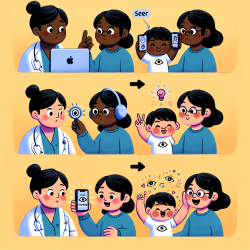Introduction
In the ever-evolving field of speech-language pathology, staying informed about the latest research is crucial for practitioners aiming to deliver the best outcomes for their clients. A recent study titled "Dynamic cortical connectivity alterations associated with Alzheimer's disease: An EEG and fNIRS integration study" offers valuable insights into the neural dynamics of Alzheimer's Disease (AD). This study utilizes a novel integration of electroencephalography (EEG) and functional near-infrared spectroscopy (fNIRS) to explore changes in brain connectivity, providing a potential pathway for enhancing diagnostic and therapeutic approaches.
Understanding the Study
The study conducted by Li et al. (2019) focuses on identifying cortical network changes associated with Alzheimer's Disease using an integrative approach combining EEG and fNIRS. This method allows for a comprehensive analysis of brain connectivity by leveraging the high temporal resolution of EEG and the spatial resolution of fNIRS. The research involved 14 participants, including 6 patients with mild AD and 8 healthy controls, performing a digit verbal span task.
Key Findings
- Patients with mild AD showed weaker cortical connectivity in the high alpha and beta bands, particularly in the orbitofrontal and parietal regions.
- The AD group exhibited lower degree and clustering coefficients at the frontal pole and medial orbitofrontal areas, indicating disrupted network integration.
- Interestingly, higher index values were observed at the superior temporal sulcus in the AD group, suggesting altered regional network properties.
Implications for Practitioners
For speech-language pathologists, these findings highlight the importance of considering neural connectivity alterations when assessing and treating individuals with Alzheimer's Disease. The integration of EEG and fNIRS offers a promising avenue for developing more precise diagnostic tools and personalized intervention strategies. By understanding the specific brain network disruptions associated with AD, practitioners can tailor their therapeutic approaches to target these areas effectively.
Encouraging Further Research
This study underscores the potential of combining multiple neuroimaging modalities to gain a deeper understanding of complex neurological conditions like Alzheimer's Disease. Practitioners are encouraged to explore further research in this area, as it may lead to the development of innovative techniques for early detection and intervention. Collaborating with researchers and staying updated on emerging technologies can significantly enhance the quality of care provided to individuals with cognitive impairments.
Conclusion
The integration of EEG and fNIRS represents a significant advancement in the field of neuroimaging, offering new insights into the cortical dynamics of Alzheimer's Disease. By embracing these findings, speech-language pathologists can improve their diagnostic accuracy and develop more effective treatment plans, ultimately enhancing the quality of life for individuals affected by this condition.
To read the original research paper, please follow this link: Dynamic cortical connectivity alterations associated with Alzheimer's disease: An EEG and fNIRS integration study.










